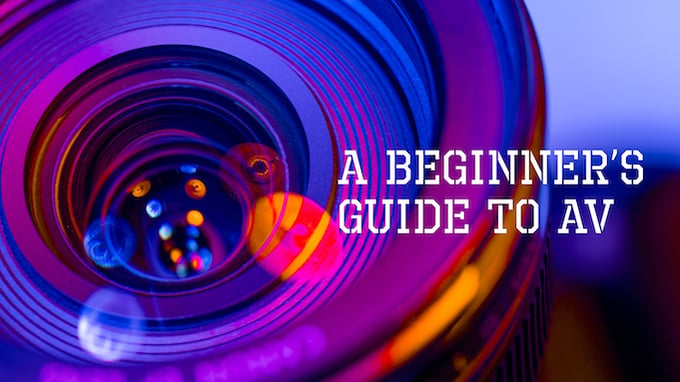
A decade ago, I left a job in management consulting with a “big 4” accounting firm and embarked on what would become my second career in the audiovisual (AV) industry. While I was planning on making a career change, going into the AV industry was in no way my targeted path. Other than appearing in a high-school play, earning a degree in electrical engineering and occasionally attending theatrical performances, I was neither had a theatre background nor the foundational knowledge that would have been helpful in preparing me for what lay before me.
- The importance of mentors
- What is AV?
- AV everywhere you look
- Fast-changing industry
- See beyond the technology
The importance of mentors
On entering the AV industry, I immediately found myself over my head in concepts, terminology, TLAs (three letter acronyms, plus or minus a letter) and technology that was completely foreign to me. Fortunately, I had two good mentors to help me get my footing and keep the flow of new information a steady stream instead of a firehose (a shoutout here to James Kellner and the late Mark Watzl).
Thinking back to late 2010, I wonder what my journey would have been like if I did not have these mentors. What do I wish I knew sooner than later? What questions should I have been asking? What resources should I have been leveraging to gain knowledge and understanding?
Drawing on my personal experience and with guidance from the TheatreArtLife team, I will attempt in this series of articles to define the terminology and explain the general concepts of the AV industry. Caveat emptor: In no way is my knowledge complete or perfect. I, myself, am still learning and trying to keep abreast of the rapidly changing technology in our industry. However, I will do my best to provide accurate basic information and, where appropriate, point to sources of more detailed information. I apologize in advance if some of my explanations are overly simplified.
WHAT IS AUDIOVISUAL?
First, let us start with the definition of audiovisual and the AV industry. According to Merriam-Webster, audiovisual refers to that which is (1) “designed to aid in learning or teaching by making use of both hearing and sight” and (2) “of or relating to both hearing and sight.” The dictionary also sites its first use as occurring in 1902. However, according to Wikipedia, the concept may have existed as early as 1895 with the introduction of the Kinetophone by Thomas Edison. It combined his Kinetoscope, an early motion picture device, with his cylinder phonograph to create the first integrated audio and video experience.
AV IS everywhere you look
Today, AV covers a broad range of applications including digital theatre scenery, digital signage, integrated meeting and collaboration rooms, live events, hybrid events, public art, home entertainment and much more. It is practically impossible to not bump into something AV related as we conduct our daily routines. This has been increasingly true over the past year as distance learning, virtual conferences and live-streamed events, all of which incorporate elements of AV, have become much more prevalent in our lives.
Enabling these AV applications is an equally broad range of equipment manufacturers, distributors, value-added resellers, systems integrators, and professionals including consultants, designers, programmers and technology managers (Wikipedia, reference here). The industry also represents an important portion of the global economy. The latest 2021 Industry Outlook and Trends Analysis (IOTA) from trade association AVIXA, forecasts revenue will touch $232 billion in 2021 (after a drop to $214 billion in 2020) and grow to $329 billion in 2026.
a fast-changing industry
From a technology perspective, this is also a fast-changing industry. When I started in the industry (and from my perspective) DVI (Digital Visual Interface) was the connector type of choice, content was mostly HD (High Definition) and encoded as MPEG-2, HDBaseT was a new technology and projectors were the predominate display devices. Today, the equipment we sell utilize DisplayPort or HDMI connectors, content is produced in UHD (Ultra High Definition — 4K and larger) using codecs like HAP and NotchLC, AV over IP is increasingly becoming mainstream, and video walls (multiple high-resolution monitors) and LED walls as display devices are extremely common as is viewer interactivity.
see beyond the technology
Reflecting on my journey so far, I cannot think of a more exciting industry with which to be associated. AV combines art, performance and technology – three things for which I have always had an appreciation. Along the way, I have also met many wonderful and fascinating people. Rarely have I encountered anyone who was not willing to help or offer objective advice when needed. Yes, at times the breath of concepts, technologies and jargon can be overwhelming and frustrating. However, once you understand the basics and recognize that our industry is ultimately about teaching, storytelling and creating an experience, the rest quickly falls into place.
Previously published on TheatreArtLife, a platform for industry professionals from all live entertainment genres to connect and learn from each other!
More blogs you might like:
Multiexperience – the next tech trend in the AV industry?
Leaders: Do you create or hinder success?
Guide to becoming a media server professional:



